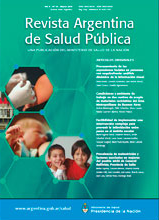Scorpionism and first records of Tityus trivittatus and Tityus serrulatus in Puerto Iguazú, province of Misiones
Keywords:
Toxicology, Scorpions, Ecoepidemiology, Public Health Surveillance, Travel MedicineAbstract
Accidents caused by scorpions are the main cause of hospital consultation in events with poisonous animals in Argentina. The Misiones´ city of Puerto Iguazú is a tourist and border city, which makes the incidental mobility of fauna and the alteration of the assemblages of the local biological groups probable. The objective of the work was to evaluate the temporal and spatial patterns of scorpionism and to update the assembly of scorpions of health interest. METHODS: A descriptive observational study was conducted from
the databases of the National Institute of Tropical Medicine and the SAMIC Hospital (Community Integral Medical Care Service) in Puerto Iguazú. RESULTS: In 2013-2019, 57 scorpions were identified, with 37 accidents without death. 76% of the accidents involved the genus Tityus; T. bahiensis was the main and most frequent species. The accidents were mostly in the home and in the resident population. Records showed seasonality and correspondence with the number of accidents. Two populations of T. trivittatus were detected in the city. The first accident by T. serrulatus was recorded in Argentina. DISCUSSION: The action of the technical-sanitary services allowed the detection of two species not registered in the locality, both of which are highly dangerous (in particular T. serrulatus, since there is no antiserum in the country).
Downloads
Downloads
Published
How to Cite
Issue
Section
License

This work is licensed under a Creative Commons Attribution-NonCommercial-ShareAlike 4.0 International License.


